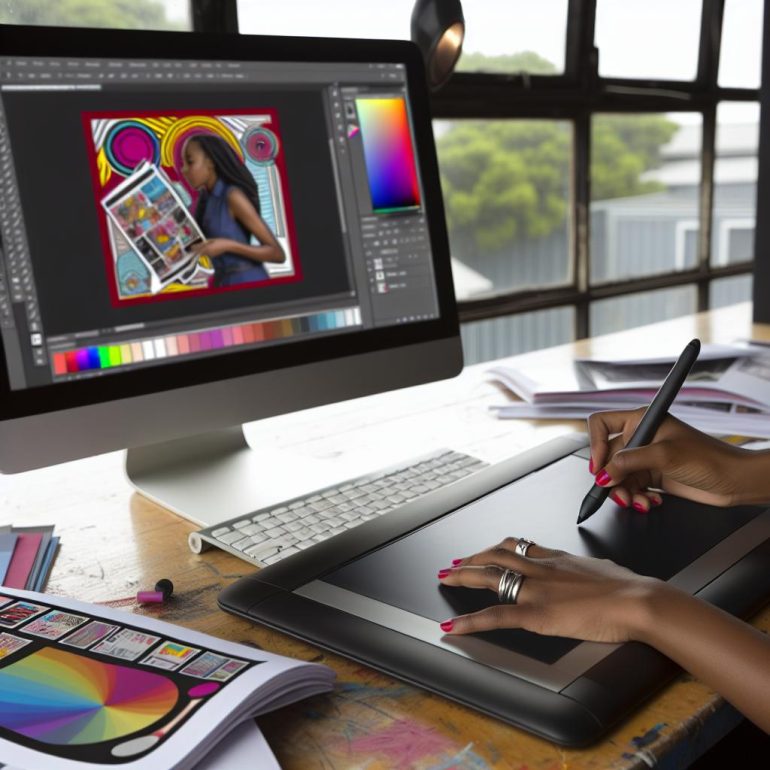The Importance of Graphic Design in Ezine Publishing
In the ever-evolving digital landscape, ezines, or electronic magazines, have become a pivotal platform for reaching audiences online. They blend insightful content with captivating design, making them a powerful medium for communication. A crucial component of their success is graphic design.
Enhancing Visual Appeal
Graphic design is essential for making ezines visually appealing. A well-designed ezine can attract and retain readers by using a blend of images, colors, and typography. Effective use of these elements can make the content more engaging and easier to read. When images break up large blocks of text, readers are less likely to feel overwhelmed, thereby increasing their read-through rates.
The integration of graphic elements does more than just beautify the page; it can significantly impact the way readers consume and process information. The choice of color can evoke specific emotions or thoughts, setting the tone for the ezine and aligning with its thematic content. Typography, too, plays an essential role. Factors such as font choice and size can either facilitate easy reading or act as a barrier. By carefully selecting these design elements, an ezine can enhance the overall reading experience.
Brand Consistency
Incorporating consistent design elements throughout an ezine promotes brand recognition. It ensures that the ezine aligns with the brand’s identity outside the publication. This consistency is crucial for establishing trust and familiarity with the audience. Companies often use specific fonts, color schemes, and logo placements as part of their overall branding strategy.
Consistency extends beyond just visual appeal—it encompasses how the brand communicates its values and message. When a reader flips through an ezine, they should be able to recognize the brand’s signature style instantly. This recognition creates a seamless experience across various platforms, reinforcing the brand’s identity in the minds of the audience. In the competitive world of digital content, maintaining this sense of continuity can be the key differentiator that keeps a brand at the forefront of a reader’s mind.
Improving User Experience
Graphic design plays a significant role in enhancing the user experience of an ezine. By organizing content logically and aesthetically, graphic designers can guide readers through the ezine more smoothly. Elements such as headings, subheadings, and bullet points help in structuring the content, making it easier for readers to find the information they want quickly.
Interactive Elements
In the digital age, readers expect more than just static content. Graphic design enables the incorporation of interactive elements like clickable links, videos, and infographics, adding an interactive dimension to ezines. These elements not only engage readers but also provide additional layers of information. Integrating multimedia content can enhance storytelling, giving readers a richer experience.
The inclusion of interactive components like hyperlinks and embedded videos transforms passive reading into an active engagement process. This interactivity allows readers to explore content at their leisure, diving deeper into topics that capture their interest. Moreover, interactive graphics can provide a dynamic way to present data or narratives, catching and holding the reader’s attention longer than static images might.
Conveying Messages Effectively
An important function of graphic design is in ensuring that messages are conveyed clearly and effectively. Through the strategic use of visuals, designers can highlight important information and guide the reader’s attention to essential content. Graphics such as charts and diagrams can simplify complex data, making it accessible and understandable to a broader audience.
Clarity and Simplicity
While aesthetic appeal is vital, clarity and simplicity should not be overlooked. A cluttered design can confuse and deter readers. Graphic designers should ensure that each element serves a purpose and contributes to the overall narrative of the ezine. This balance between visual flair and functionality is crucial for maintaining reader interest.
A clear and simple layout not only facilitates better understanding but also reduces cognitive load on the reader. When information is presented in a straightforward manner, with a logical flow and without unnecessary distractions, it becomes much easier for the audience to digest and retain information. This simplicity in design echoes the broader philosophy of effective communication: be clear, be concise, and be purposeful.
The Future of Graphic Design in Ezines
The future of ezine publishing seems promising with advancements in graphic design technology. Tools that leverage artificial intelligence and design automation are simplifying the process, allowing for more creative and complex designs. As technology continues to evolve, so will the opportunities to enhance the visual and functional aspects of ezine publications.
The integration of AI-driven tools in the design process opens new horizons for customization and personalization. Designers can now tailor visual content to fit diverse audience preferences, optimizing reader engagement. Furthermore, as virtual and augmented reality technologies become more mainstream, they promise to bring a new dimension to ezine storytelling, offering immersive experiences that break the bounds of traditional design.
In conclusion, graphic design is integral to the success of ezines. It enhances visual appeal, maintains brand consistency, improves user experience, and ensures effective communication of messages. As technology advances, the role of graphic design will undoubtedly expand, further shaping the future of digital publications.
By continuously evolving alongside technological advancements, graphic design remains at the core of ezine publishing. Its capacity to create dynamic, engaging, and cohesive content experiences ensures that ezines will continue to be a relevant and compelling medium in the digital era. As we look to the future, embracing these innovations will be key to maintaining the vitality and effectiveness of ezine publications.

